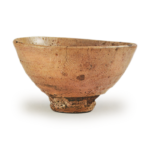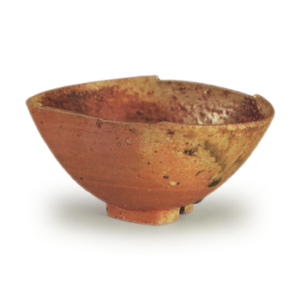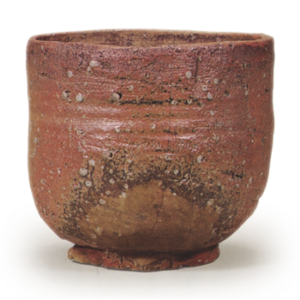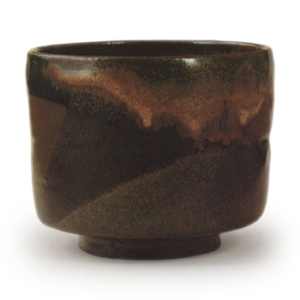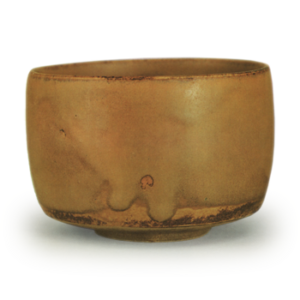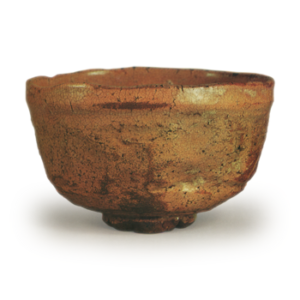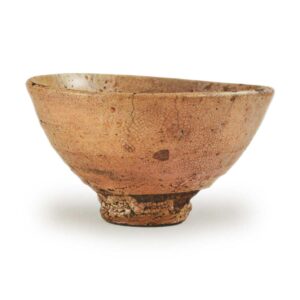
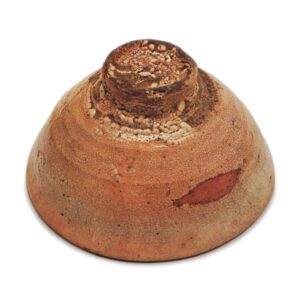
Name: Honda Ido
Daimyo-butsu (treasured by a feudal lord) National Treasure
Daitokuji Kobōan
Height: 9.1cm
Diameter of the bowl: 15.3-15.5cm
Diameter of the shoulder: 5.2-5.5cm
Height of the shoulder: 1.5-1.7cm
This is a famous bowl that is well known throughout the land. It was owned by a merchant in Osaka called Kizaemon Takeda during the Keicho period, and so it is also called Kizaemon’s Well. It was presented to Honda Noto no Kami Tadayoshi, and so it is also called Honda’s Well.
The base is rough earth mixed with sand, and a semi-transparent glaze is applied thickly over this, with rough cracks appearing all over. Generally, because it is fired in an oxidizing flame, both the inside and outside are a loquat color, but there are also areas that have a slight bluish tinge. With its thickly-painted rim, full body and solid foot, this is a very dignified and imposing tea bowl, and its appearance is unsurpassed.
Three thick, dark brown finger marks circle the waist, and the foot is raised on both the inside and outside with a single tool, creating what is commonly known as a bamboo joint foot. Of the many well-known tea bowls, none have a more attractive foot than Kizaemon’s. The so-called “kairagi” pattern is created by scraping the foot with a spatula, leaving the clay rough, but it is also thought that in Korea, the glaze is made to shrink by using a shell as a solvent, and the strong acidity of the shell causes the glaze to shrink, resulting in the kairagi pattern. Of course, depending on the heat, if it is fired too strongly, the kaeragi will melt and run off. In the case of Kizaemon, the crinkling is particularly severe, and the underside of the base, for example, has a crinkled pattern like polka dots, and the part of the foot ring that has been cut away by the Kōdai Kyō is exposed to the bare clay. There was a person who once published an opinion that the Kizaemon well was glazed, then the glaze on the side of the foot ring was scraped off, and then the foot ring was glazed again, but I think this is a mistake. There is no way that they would have gone to such trouble to make a mistake in the firing of a well, which was originally a company-made utensil, let alone in Korea. The thick glaze and the particularly strong shellfish acidity should be seen as the scenery of the foot ring, which was created by the glaze peeling off on one side. On the outside, there is an unglazed part called the “fire space”. Also, because the bowls were stacked on top of each other in the kiln, the rim of the bottom bowl was burned onto the body, and the marks where this was scraped off have been repaired with lacquer in the shape of a fish.
There are also several small scratches on the rim that have been repaired with lacquer, and there are several short vertical cracks, but there are no particularly noticeable cracks or breaks, and for a well with fragile clay that is prone to scratches, it is in good condition.
The inside is a loquat-colored, deep well with a sharp lathe mark in the center and a glaze avalanche in the middle. There are quite a few wells with a layered firing mark on the inside, but Kizaemon does not have one. Both Hosokawa and Kaga are said to be characterized by the fact that the Mitsui-do wells of Fumai-dono do not have a mark on the inside.
Inner box: black lacquer, gold powder lettering on the lid: “In the possession of Honda Noto no Kami Tadayoshi, with a letter from Funakoshi Iyo no Kami, ito-chawan”
Inner box paulownia wood, lid: “Korea, well, Honda”
On the reverse of the lid, Araki Issai: “Possessed by Honda Noto no Kami, ” Bureau Rei well tea lamentation, around the Keicho era, called Kizaemon, and the old Kizaemon Ido Fukuun, Funakoshi Iyomori-dono played with this book, and later when it was handed over to the county of Kazusa, it was sought by Sosen Soun of Kinzan Village, and now it is in the possession of the Tange family.
In the An’ei era, it became the property of Matsudaira Fumai, but in the fifth month of the fifth year of the Bunsei era, his wife Shourakuin presented it to the Kobouan temple in Daitokuji, Kyoto.

